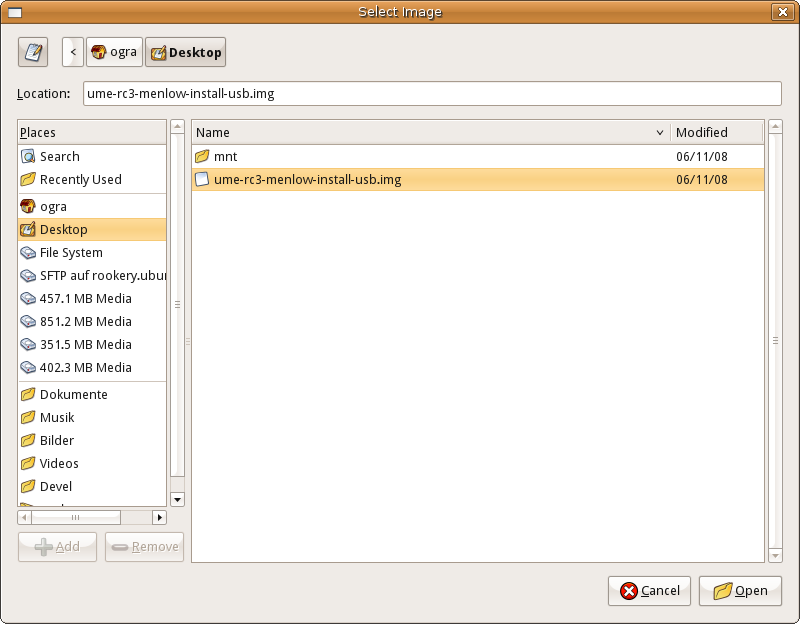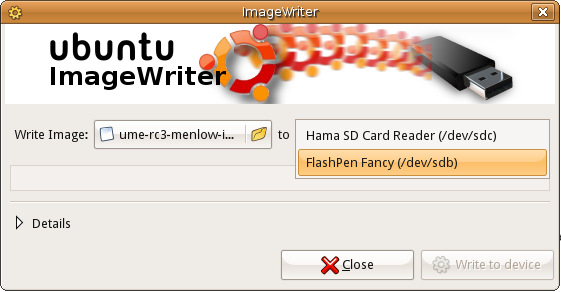
Yesterday April 23rd, 2009 is official launch day for latest Ubuntu and it's all brother & sister. The most tempted variant for me is Ubuntu Netbook Remix 9.04 Jaunty Jackalope. It's an answer for a brand new emerging market in mobile computing, NETBOOK. Unfortunately till evening in my local time, there are only older Ubuntu available to download. Finally on April 24th, i got the link ready and in the afternoon I have Netbook Remix completely downloaded to satisfy my curiosity.
What is a remix?
A remix is a 'respun' version of Ubuntu built for a specific purpose. Although Canonical has encouraged community projects to use this terminology for some time, this is the first time that Canonical has used it. We are using it to differentiate from an 'Edition' which we consider a complete version with daily builds suitable for the average user with no additional work beyond installing the CD.
Canonical works with devices manufacturers (OEMs) to pre-install Ubuntu Netbook Remix. These commercial products contain software that is not free and built for a specific hardware configuration unique to the OEM. These are not publicly available as we do not have the right to redistribute the software.
All of the initial Ubuntu Netbook remixes combine optimisations from the Moblin project for Intel® Atom™ processors and it is specially designed for netbooks. Intel and Canonical are working to create a new computing experience across a rapidly expanding category of portable devices.
Reasons to choose Ubuntu Netbook Remix
For OEMs:
* Rapid route to market - UI configured to work with Intel Atom processor-based netbooks so you are ready to go
* Small OS footprint - fits within a 4GB flash drive with room for additional storage
* Expert engineering - based on Ubuntu’s well-tested, globally proven software
* Clean licensing - all work conforms with open source and commercial application licensing with audio and video codecs that are legally licensable
For users:
* New Interface - built for accessing your favourite on and off-line applications rapidly and optimised for the restricted screen size this is radically different
* No viruses - Ubuntu is a smooth, safe computing and browsing experience
* Optimised for netbook components - built from the ground up to take advantage of speed and power capabilities of the chip set
* Large developer community - gain the benefits of innovation from some of the world’s leading free and open source developers
Technical specifications
Minimum hardware requirements:
* Processor: Intel® Atom™ processor
* RAM: 512 MB
* Storage: 4 GB Flash disk (SSD) or hard disk
Major open source applications included:
* Web browser - Firefox 3
* E-mail client - Evolution
* Instant messenger - Pidgin
* Media player - Rhythmbox
* eBook reader - FBReader
* Photo viewer - F-Spot
* Office suite - OpenOffice.org
Optional market leading applications included:
* Adobe Flash
* Adobe Reader
* Java JVM
* Skype
Optional licensable audio and video decoders for OEMs:
* MPEG4 (H.263)
* MP3
* AAC
* Windows Media
History (from Ubuntu.com & markshuttleworth.com):
Completely independently, a set of Canonical developers from the OEM team was looking at technologies to support the new "netbook" devices. Using a mix of GNOME, Open Hand stuff, some of the work that went into Ubuntu MID, and additional development, they produced the "Netbook Remix", based loosely on Ubuntu Hardy. This Remix included 4 new packages, and patches to about 59 more.
For the rest, the netbook remix uses standard ubuntu packages from the standard ubuntu archive, with standard security updates. So it meets all of our usual commitments around security and compatibility. You can recreate the netbook remix just by installing 8.04, adding the PPA to your list of repositories, fetching the packages and configuring them appropriately for your system.
The netbook remix is not part of the “official Ubuntu editions”, it’s not like Kubuntu or Ubuntu or Ubuntu Server. It’s a separate remix published by the Canonical OEM team. It will probably get revved in October when Ubuntu 8.10 is released, but that’s up to the Canonical OEM team and their customers, and not the responsibility of the Ubuntu project team.
In working with manufacturers, the OEM team creates custom install images which are specific to hardware from those OEM’s. They have the free software packages I’ve described, and they may also include third-party software selected by OEM’s which Canonical cannot redistribute, so we can’t publish the custom installers that are produced under contract. Those images typically are hand-customised for a faster boot time, which means they will only work on the particular device for which they were intended, unlike standard Ubuntu which should auto-detect and configure itself for whatever hardware it is being booted on.
We specifically wanted to do this project as an Ubuntu Remix - based on standard Ubuntu 8.04 packages, with modified package selection and some additional code, but leaving the core platform packages unmodified. In terms of the trademark guidelines for an Ubuntu Remix companies cannot call their platform Ubuntu if they have modified packages (especially the kernel and desktop packages) but they can if they are just re-arranging standard Ubuntu packages. Canonical is in a privileged position as the Ubuntu trademark owner - we can certify a custom kernel if we believe it has been done in an appropriate way that won’t conflict with standard Ubuntu maintenance processes, and if we can keep the custom kernel up to date to the same standard as the normal Ubuntu kernel. So these are certified Ubuntu devices from Canonical, even though they are more customized than other people can within the Remix guidelines.
We’re also working with two companies that want more radical user interface innovation. Canonical is participating directly in the design and implementation of one of those UI’s, and we’re integrating someone else’s UI on an Ubuntu base for the second project. I haven’t seen either of those UI’s, for confidentiality reasons, but I’m told that the teams working on them think they have great ideas that will elevate, in different ways, the state of the art. All in all it will be exciting to see how the netbook era stimulates innovation in the Linux user experience, because there are a lot of companies wanting to build differentiated UI’s on a standard Linux base. And directly or indirectly Canonical will help to bring that innovation to KDE and GNOME and hence to the wider Linux ecosystem.
Installation:
I use Ubuntu 8.10 Itrepid Ibex might be different with yours.
1. Download the image (not ISO image) from here
2. Install the ImageWriter. Download the DEB package from here for 8.10 Itrepid Ibex or here for 8.04 Hardy Heron /usb-imagewriter_0.1.3-0ubuntu1~intrepid~ppa1_all.deb
3. Install that package and you'll find it in Application - Accessories Menu
4. Don't forget plug your USB first and launch the ImageWriter.

5. Select the image and the USB device


6. Wait till finish



7. Installation screen shot:







I still see SUN Open Office 3.0 maybe later we'll see Oracle Open Office 3.1 or it will be the last free one?
8. I'm happy on Canonical efforts to support netbook. I already installed Ubuntu 8.10 on my kindergarten netbook Axioo and it was working fabulous, unlike disappointing experience with Windows XP on the same machine. I haven't find big different with this new version with older 8.10 but I'll dig it deeper. :)



No comments:
Post a Comment